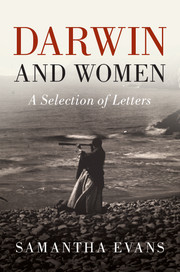Book contents
- Frontmatter
- Contents
- List of illustrations
- Foreword
- Preface
- Acknowledgments
- Symbols, abbreviations, and conventions
- 1 Friends
- 2 Marriage
- 3 Children
- 4 Scientific wives and allies
- 5 Observing plants
- 6 Companion animals
- 7 Insects and angels
- 8 Observing humans
- 9 Editors
- 10 Writers and critics
- 11 Religion
- 12 Travellers
- 13 Servants and governesses
- 14 Ascent of woman
- List of letters and provenances
- Biographical notes
- Bibliography and further reading
- Index
9 - Editors
Published online by Cambridge University Press: 16 February 2017
- Frontmatter
- Contents
- List of illustrations
- Foreword
- Preface
- Acknowledgments
- Symbols, abbreviations, and conventions
- 1 Friends
- 2 Marriage
- 3 Children
- 4 Scientific wives and allies
- 5 Observing plants
- 6 Companion animals
- 7 Insects and angels
- 8 Observing humans
- 9 Editors
- 10 Writers and critics
- 11 Religion
- 12 Travellers
- 13 Servants and governesses
- 14 Ascent of woman
- List of letters and provenances
- Biographical notes
- Bibliography and further reading
- Index
Summary
Editing provided a useful entry point into the world of science for women, even though this work was not usually acknowledged in print. For instance, Arabella Burton Buckley worked as Charles Lyell's secretary from 1864 (when she was 23) until his death in 1875. According to an article in a shortlived Liverpool journal, Research: a monthly illustrated journal of science, she was taken on as an amanuensis because of the clearness of her handwriting, but she became a secretary and indispensable literary assistant. She ‘not merely wrote Sir Charles's letters after his instructions, and ordered his very extensive scientific correspondence, but when a new edition of any of his works was called for she drew illustrations, re-cast passages, made précis of information in new works, corrected the proofs, and compiled tables and indexes’ (Research, 1 February 1889, p. 130). After Lyell's death, Buckley went on to have a distinguished career as a scientific author (see chapter 10) and lecturer.
In default of paid assistants, it was common for men of science to ask female friends and relatives to help. Sometimes help came unasked: Darwin's first editors were his sisters. Caroline Darwin, who was nine years older than him, educated him before he went to school in Shrewsbury at the age of 8. ‘I doubt whether this plan answered,’ wrote Darwin later; ‘she was too zealous in trying to improve me’ (‘Recollections’, p. 356). In this letter written to Darwin on the Beagle in 1833, however, Caroline is very guarded in her criticism:
October 28th—
My dear Charles—
I have been reading with the greatest interest your journal & I found it very entertaining & interesting, your writing at the time gives such reality to your descriptions & brings every little incident before one with a force that no after account could do. I am very doubtful whether it is not pert in me to criticize, using merely my own judgment, for no one else of the family have yet read this last part— but I will say just what I think—I mean as to your style.
- Type
- Chapter
- Information
- Darwin and WomenA Selection of Letters, pp. 136 - 147Publisher: Cambridge University PressPrint publication year: 2017

